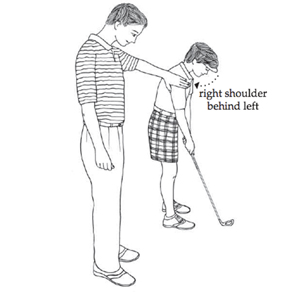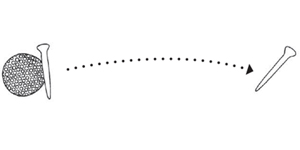Featured Golf News
Improve Your Chipping - Part I
With a chip shot the ball needs just enough height to land safely on the green, after which it rolls along the ground toward the hole. Use a pitching wedge or a 9-iron to make it easier to obtain early trajectory.

Problem
Topping (sometimes referred to as "blading") chip shots.
Probable Cause
Several backswing actions can cause the club to hit the top of the ball, thus resulting in "topping" the shot. One such action is the right wrist bending backwards, which usually forces the right elbow to bend outwards/backwards instead of downwards.
Solution
Set-up
▪ At address the arms should be as straight as possible. Think of them as "sticks," unable to bend at either the wrists or the elbows.
▪ The shoulders should remain level with one another and completely relaxed, and the right shoulder should be slightly behind the left one (see illustration).
Swing
▪ Move the "sticks" back, then past the ball, and HOLD the finish for a few seconds.
▪ Keep your nose pointed forward forever, never letting it rotate toward the hole.
Minimalist Golf Swing (MGS) Rationale
The MGS is based on a study of ball-club contact requirements for ideal impact. It then incorporates positions from which the body can most effectively get the club into these ideal impact conditions.
In a correctly executed chip shot, the club connects the ball first and then the ground. This happens when the hands are straight, and ahead of the clubface at impact.
When the right wrist and elbow bend backwards it becomes anatomically difficult for the right arm to straighten up in time for impact. When the right wrist straightens out after impact (too late), the club is only able to make a glancing blow at the top of the club, resulting in a topped shot.
Conversely, if, during the backswing, the arms are either straight or the right wrist and elbow bend in the same plane as the upper-arm (not perpendicular to it), correct impact will result.
Drills/Exercise
1. Interlock the fingers and set up as in a good chipping posture, arms hanging straight down from the shoulders. Move the arms back and forth keeping them straight at all times, then HOLD the finish position. This drill forces the arms to stay fairly straight throughout the swing.

2. Place a tee on the ground touching the ball, on the target side. If the tee flies forward towards the green, at impact, the stroke was correct and the ball was able to climb up the club's face to get some basic starting trajectory (see illustration).
Kiran Kanwar has 20 years experience as a golf instructor. She currently teaches golf in St. Louis, Mo., and in Bombay, India. At the 2008 PGA Merchandise Show Kiran exhibited a research-based golf swing that quickly gave players of any skill level better distance, direction and trajectory. She also has expertise in dramatically and rapidly increasing a golfer's swing-efficiency to preclude swing-related injury. She's a Class A teaching professional with credentials from the LPGA, the PGA (UK), the PGA of India, and the National Golf Academy of India. Among other titles, Kanwar won the Ladies All-India Open Amateur Golf Championship in 1983. A columnist for Golf Digest India, Kiran is the author of an instructional e-book - sold on her website - entitled "DIY (Do-It-Yourself) GOLF." For more information visit www.yourgolfguru.com or email her at kk@yourgolfguru.com.
Story Options
 |
Print this Story |
